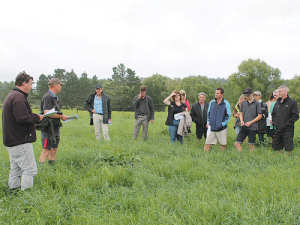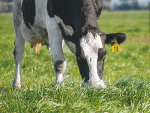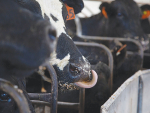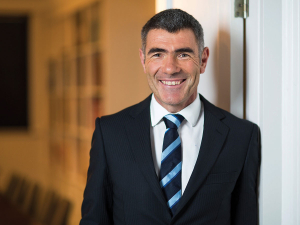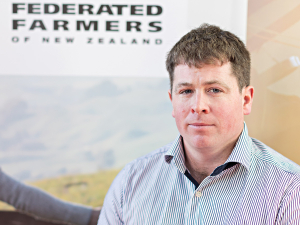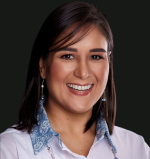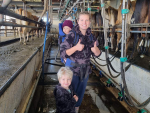“We have cows onfarm when we are growing grass; when we are not growing grass we have flexibility,” he told a Northland Dairy Development Trust field day on ‘Farm Systems for Profit’.
Neville and Ainsley bought Te Arai Farms 11 years ago as part of an equity partnership but bought out the equity partners in June 2017 and have been operating the farm themselves for the last 19 months.
The milking platform is 135ha and they grow 10.5ha of maize on that platform. They are milking 430 cows this year in a split calving system with 50% in autumn.
They decided to carry on with the split calving when they took over the farm. Neville says it was going well but they haven’t got the system nailed to best efficiency yet; they are still tweaking and there’s still plenty of potential.
The farm’s 2017-18 production was 160,178kgMS, up from 123,794kgMS the previous year and their target and long term goal is 170,000kgMS.
They milked 250 over winter; only 50 were carry-overs this year. The first year they had to bring a lot of feed in and used all their maize, says Neville. This year they have used far less imported feed and yet production was up 30% through winter.
Neville says a good autumn helped but they realised they had to stretch the round out and fill that feed wedge up especially with split calving. They went on a 40 day round on May 1, by June 1 they went to 50 day round and July 1up to 60 days.
“You’ve got to get a good feed wedge ahead of you so when your spring cows start calving you’ve got grass to feed them.”
AgFirst Northland consultant Gareth Baynham says split calvers especially need to think about how to build cover and spring rotation.
Neville says with split calving they can supply milk when it is worth more. They get a winter premium: for 15 days in May it is $2.85/kgMS, in June $3.50/kgMS more and in July for another 15 days they get a $2.85/kgMS premium. There is a 7.5c/kgMS transport cost on that.
He says in the months of September, October, November and December you get paid 61c/kgMS less for supplying milk to the factory. So the system works out to a positive 30c/kgMS for them over the bulk of the season.
“The other thing about split calving is it is a lot easier to manage FEI (fat evaluation index). If we have a dry summer we can choose to feed or else we can dry cows off. The other thing is we can use supplements when they are cheaper.”
A disadvantage of split calving is milking every day of the year but they employ three fulltime staff. Some may say that is overkill, he says, but that way everyone gets adequate time off and the system keeps running. Gone are the days when you can work your staff for “hours and hours and hours”.
There’s less risk of over-grazing in a dry summer with split calving. “If it gets really dry cows can put a lot of pressure on your pastures and pull it out. They can do as much damage as pugging through winter.”
Also, he says, people can spend a lot on cooling their milk in summer but their milk curve is so flat that they don’t have any problems with milk temperature.
“The aim is to put every blade of grass in the bank when it is most profitable. The system is very flexible in different situations.”
Baynham says using split calving is a way of shifting feed demand and a good compromise when juggling things like FEI and using alternative feeds to PKE.
Set rotation
In pasture management, Te Arai Farm’s key focus is leaving the right residuals to ensure quality feed next rotation.
The aim is to make the cows graze to target residuals. They will put them back in the paddock to reach the right residuals but are prepared to top if necessary or be proactive in making baleage.
Silage is cut while the grass is relatively short to improve re-growth.
They use reels and standards all year to get the allocation right, often cutting off one quarter of the paddock to use the following day then move cows on.
Taking the maize silage area out increases the spring stocking rate to 3.3 cows/ha (feed demand of 55-60kgDM/ha/da) and helps prevent surplus pasture.
No plate metering is carried out. The cows graze the farm in a rotation and each herd grazes half the farm; sometimes the herds will switch over. Having all the pre-grazing and post-grazing paddocks in the same part of the farm helps to see how much grass is in front of the cows and keeps an eye on residuals/regrowth. The hectares offered to the cows and supplement use can be fine-tuned each day.
Neville says they use nitrogen in April, May, June and July through to December when the response is huge as long as you can use the grass. That enables them to grow maize because when the grass is taking off you don’t notice 12ha out of your system.
With split calving “when things start drying out in January-February half your herd is going. It is easier to grow a crop of maize and it doesn’t have a big effect on the system. If you are all spring calving and you take all that area out you really notice it in January and February.”
Reproduction is an area that Neville is working on. Empty rates have been in the mid-20s but were 15% for the autumn 2018 mating.
Neville’s current focus is doing a great job on young stock. Calves remain on the milking platform until they are above Minda weight targets.
Autumn born calves averaged 140kgLW in mid-August. Nothing is weaned below 100kg LW (probably average 108kgLW at weaning) and calves get a mixture of meal, maize silage and PKE.

